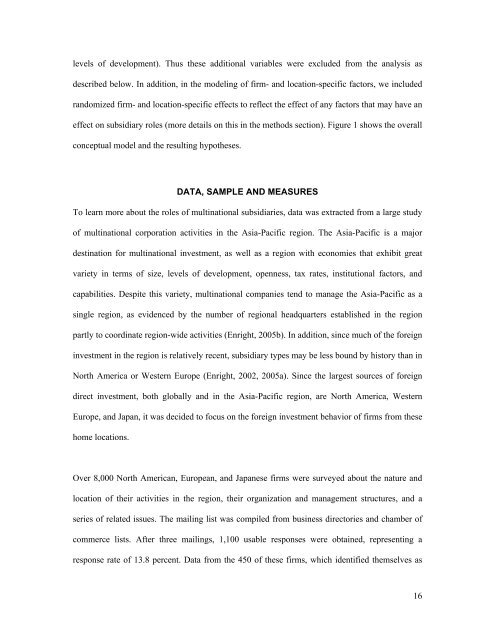Subsidiary Types, Activities, and Location: An Empirical Investigation
Subsidiary Types, Activities, and Location: An Empirical Investigation
Subsidiary Types, Activities, and Location: An Empirical Investigation
Create successful ePaper yourself
Turn your PDF publications into a flip-book with our unique Google optimized e-Paper software.
levels of development). Thus these additional variables were excluded from the analysis asdescribed below. In addition, in the modeling of firm- <strong>and</strong> location-specific factors, we includedr<strong>and</strong>omized firm- <strong>and</strong> location-specific effects to reflect the effect of any factors that may have aneffect on subsidiary roles (more details on this in the methods section). Figure 1 shows the overallconceptual model <strong>and</strong> the resulting hypotheses.DATA, SAMPLE AND MEASURESTo learn more about the roles of multinational subsidiaries, data was extracted from a large studyof multinational corporation activities in the Asia-Pacific region. The Asia-Pacific is a majordestination for multinational investment, as well as a region with economies that exhibit greatvariety in terms of size, levels of development, openness, tax rates, institutional factors, <strong>and</strong>capabilities. Despite this variety, multinational companies tend to manage the Asia-Pacific as asingle region, as evidenced by the number of regional headquarters established in the regionpartly to coordinate region-wide activities (Enright, 2005b). In addition, since much of the foreigninvestment in the region is relatively recent, subsidiary types may be less bound by history than inNorth America or Western Europe (Enright, 2002, 2005a). Since the largest sources of foreigndirect investment, both globally <strong>and</strong> in the Asia-Pacific region, are North America, WesternEurope, <strong>and</strong> Japan, it was decided to focus on the foreign investment behavior of firms from thesehome locations.Over 8,000 North American, European, <strong>and</strong> Japanese firms were surveyed about the nature <strong>and</strong>location of their activities in the region, their organization <strong>and</strong> management structures, <strong>and</strong> aseries of related issues. The mailing list was compiled from business directories <strong>and</strong> chamber ofcommerce lists. After three mailings, 1,100 usable responses were obtained, representing aresponse rate of 13.8 percent. Data from the 450 of these firms, which identified themselves as16
















